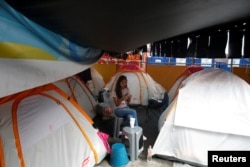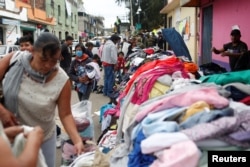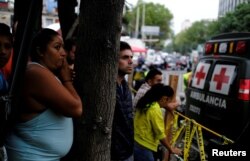Mexico City's infamous traffic jams were back on Monday as offices re-opened after last week's deadly earthquake, but closed schools and clusters of homeless people served as reminders that life in the megalopolis has not yet returned to normal.
The 7.1 quake on Sept. 19 killed at least 325 people and left thousands homeless, with many of them living in tents in the streets or emergency housing. Others among the 20 million people who live in greater Mexico City were gradually resuming their routines, however.
"You can't say that everything has totally returned back to being normal, but we do feel more safe that we did last week," said market researcher Diego Sandoval, 27, back at work in an office in trendy Condesa, one of the worst hit areas of town, and lining up at a taco stand with a dozen other office workers and laborers.
The most visible sign of the city coming back to life were the rush hour queues after a week of eerie quiet along the avenues and highways that criss-cross the capital, known for its gridlock.
"We just opened up today, getting things back on track.
We've been closed since the earthquake," said Martha Bertha Martinez, 70, who along with her sister runs a small grocery store in Tlalpan, a southern neighborhood.
"Life goes on," she said.
More than 44,000 schools in six states were due to reopen on Monday, but only 103 in Mexico City, or barely 1 percent of its schools, were set to resume classes after they were certified as structurally safe. Officials said they did not want to impede relief efforts, so more than 4,000 public schools and nearly as many private schools in the capital will remain closed for now.
The National Autonomous University of Mexico, with 350,000 students at campuses in and around Mexico City, resumed classes on Monday.
Of 6,000 damaged buildings, some 1,500 have yet to be inspected, said Horacio Urbano, president of Centro Urbano, a think tank specializing in urban issues and real estate.
Urbano said 10 percent of the damaged buildings were constructed after 1990, by which time strict building codes had been enacted in the wake of the 1985 earthquake that killed some 10,000 people.
Search for Survivors
Search operations for quake survivors in Mexico City were narrowed to five buildings, using advanced audio equipment to look for signs of life beneath tons of rubble, with help from teams from as far afield as Israel and Japan.
At a school in southern Mexico City where 19 children and six adults had previously been reported killed, officials recovered another body on Sunday, that of an adult women.
The search for survivors and bodies also carried on at a ruined office building in the Roma neighborhood and in a five-story apartment building in historic Tlalpan.
Even with offices and businesses opening up again, it will take months or years for neighborhoods like Condesa to recover emotionally and physically from the quake and aftershocks, with numerous residents packing up belongings and moving out.
"Our neighborhood is in mourning," said Deborah Levy, 44, in Condesa. "Some neighbors and friends got together [Sunday]. We went to eat to cheer ourselves up, looking for a little normality."
Florist Josue Castillo reopened the stall he has been tending for 15 years the day after the quake, "so people could see something pretty," he said, between the ruins of buildings and cordoned off streets.
But he said residents and businesses still did not feel safe in the area, which became the heart of Mexico City's hip revival over the past decade.
"People are leaving their homes and offices in Condesa.
Leaving with their families. It was horrible yesterday to see people filling their cars with belongings and moving elsewhere out of fear of aftershocks," he said.













